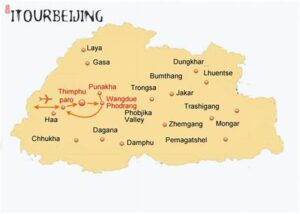Bhutan
Discover the Land of Gross National Happiness.
Nestled in the heart of the Himalayas, Bhutan is a kingdom of breathtaking landscapes, ancient monasteries, and vibrant cultural traditions. Often referred to as the “Land of the Thunder Dragon,” Bhutan offers travelers a unique and enriching experience unlike any other destination. Here’s everything you need to know about traveling to Bhutan:
1. Visa and Entry Requirements: Traveling to Bhutan requires a visa, which must be arranged through an authorized Bhutanese tour operator. Visitors must also book their travel to Bhutan through a licensed tour company, as independent travel is not permitted. Additionally, tourists must pay a daily tariff set by the government, which covers accommodation, meals, transportation, and a licensed guide.
2. Getting There: The main gateway to Bhutan is Paro International Airport, which serves flights from major cities like Delhi, Kathmandu, Bangkok, and Singapore. Drukair, the national carrier of Bhutan, and Bhutan Airlines operate regular flights to and from Paro. Alternatively, travelers can enter Bhutan by road from neighboring India, crossing the border at Phuentsholing or Samdrup Jongkhar.
3. Best Time to Visit: The best time to visit Bhutan is during the spring (March to May) and autumn (September to November) seasons when the weather is mild, and the skies are clear. These months offer ideal conditions for trekking, sightseeing, and outdoor activities. However, Bhutan’s lush green valleys and vibrant festivals make it a year-round destination worth exploring.
4. Cultural Highlights: Bhutan is renowned for its rich cultural heritage, manifested in its ancient monasteries, dzongs (fortresses), and traditional festivals. Visitors can explore iconic landmarks such as the Tiger’s Nest Monastery (Taktsang Palphug), Punakha Dzong, and Dochula Pass, which offer panoramic views of the Himalayas. Witnessing colorful festivals like Paro Tsechu, Thimphu Tshechu, and Jambay Lhakhang Drup provides insight into Bhutanese culture and spirituality.
5. Outdoor Adventures: Adventure enthusiasts will find plenty to do in Bhutan’s pristine natural landscapes. Trekking is a popular activity, with routes ranging from gentle walks through rice fields to challenging treks in the high Himalayas. The Snowman Trek, Druk Path Trek, and Jomolhari Trek are among the most famous trails. Other outdoor pursuits include mountain biking, white-water rafting, birdwatching, and camping amidst stunning scenery.
6. Cuisine and Dining: Bhutanese cuisine is a delightful blend of flavors and spices, with dishes often featuring rice, chili peppers, cheese, and meats like yak and chicken. Must-try dishes include ema datshi (chili and cheese stew), momo (dumplings), and paksha paa (pork with red chili). Visitors can savor authentic Bhutanese cuisine at local restaurants, farmhouses, and cultural events, gaining insight into the country’s culinary traditions.
7. Gross National Happiness: Bhutan is famous for its unique development philosophy of Gross National Happiness (GNH), which prioritizes holistic well-being and sustainable development over material wealth. Traveling to Bhutan offers a glimpse into this philosophy, with its emphasis on environmental conservation, cultural preservation, and community harmony. Visitors often find themselves inspired by Bhutan’s tranquil way of life and deep spiritual ethos.
8. Respect for Tradition and Environment: Bhutan places great importance on preserving its cultural heritage and natural environment. Visitors are encouraged to respect local customs, dress modestly, and seek permission before photographing people, especially during religious ceremonies. Additionally, Bhutan is committed to maintaining its pristine environment, and travelers are expected to practice responsible tourism by minimizing their impact on the environment and supporting eco-friendly initiatives.
9. Accommodation Options: Bhutan offers a range of accommodation options to suit every traveler’s preferences and budget. Visitors can choose from luxury resorts, boutique hotels, cozy guesthouses, and homestays, each offering warm Bhutanese hospitality and modern amenities. Staying in traditional Bhutanese-style accommodations, known as farmhouses, provides a unique cultural experience, allowing guests to immerse themselves in local life and customs.
10. Safety and Security: Bhutan is considered one of the safest destinations in the world, with low crime rates and a welcoming atmosphere. The country’s serene and peaceful environment, coupled with the warmth and hospitality of its people, ensures a memorable and stress-free travel experience. However, travelers are advised to take necessary precautions, such as respecting local customs and laws, safeguarding personal belongings, and following safety guidelines during outdoor activities.
Traveling to Bhutan is a journey of discovery, where ancient traditions, breathtaking landscapes, and timeless wisdom converge to create an unforgettable experience. Whether exploring sacred monasteries, trekking through pristine wilderness, or savoring the flavors of Bhutanese cuisine, visitors are sure to be enchanted by the kingdom’s charm and beauty.
Top 14 best places to visit in Bhutan
1). Taktsang
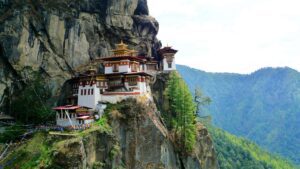
Nestled directly into the steep hills of the Bhutanese mountains, just north of the picturesque town of Paro, the majestic buildings of Taktsang Monastery are perhaps the most picturesque and legendary in all of the Himalayas.
Built-in the late 17th century, the site marks the famous place where Guru Padmasambhava is said to have meditated for three full years. Today, this revered Guru is hailed as the guardian of Bhutan and the person who introduced Buddhism to the country.
Visitors come to explore this fascinating history in the middle of the gilded Taktsang Temple: the great tiger’s nest of the Paro Valley.
2). Paro
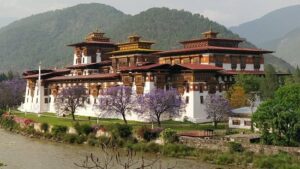
Paro is located in the heart of a large valley on the western edge of the Bhutanese Himalayas.
The beauty of its streets and well-painted half-timbered houses contrast with its modern architecture (Paro was rebuilt in the 1980s, and all works follow the traditional architecture of the region), it is the roof of these white buildings is high. Rinpung Dzong is beautiful. Half monastery, half fortress, this wooden-walled tower is one of the finest examples of military religious architecture in the country.
At the top is where tourists will find the National Museum of Bhutan, which is hidden in an ancient watchtower on top of the hill.
3). Thimphu
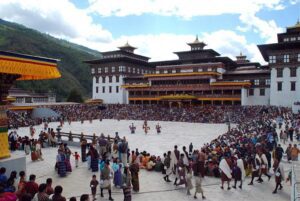
Straddling the inhospitable Raidak River, in its own small cleft between the Western Bhutanese Himalayas, Thimphu is a place of curiosity.
With its old temples and monasteries, it reflect the Buddhist beauty of the past century, while the arrival of the motorway and modern trade gives it the vitality and beauty of a new capital. Monuments also abound, from the 15th-century Changangkha Lhakhang to a large bronze statue of Sakyamuni Buddha with his mountain view.
Don’t miss the massive Trashi Chhoe Dzong, which houses the Bhutanese government today.
4). Tarongsa
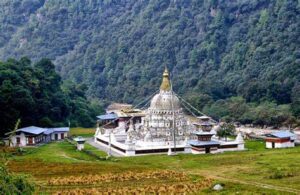
When it comes to Bhutan’s white dzong gardens, few can live up to the size and beauty of Trongsa Dzong.
Yes, this large half-timbered house and roofed chapel has been built on a small outcrop above the Mangde River. It was once the ancestral seat of the Wangchuck dynasty, which is today the royal family of Bhutan.
Although the state machinery has moved to Thimphu, this great palace still has great political and religious importance and has the most beautiful 15th and 16th-century architecture in the region.
5). Jakar
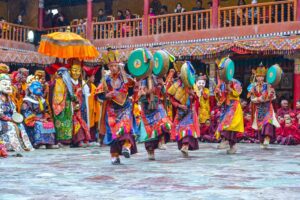
Jakar, located in the picturesque Bumthang Valley of central Bhutan, is a charming town known for its rich cultural heritage, stunning landscapes, and spiritual significance. As the largest town in the Bumthang district, Jakar serves as the administrative and economic center of the region, while retaining its traditional Bhutanese character.
One of the highlights of Jakar is the Jakar Dzong, a majestic fortress monastery perched on a hilltop overlooking the valley. Built in the 17th century, the dzong is an architectural masterpiece adorned with intricate woodwork, colorful murals, and sacred relics. Visitors can explore its courtyards, temples, and administrative offices, immersing themselves in Bhutan’s religious and cultural heritage.
Another prominent attraction in Jakar is the Jambay Lhakhang, one of the oldest temples in Bhutan believed to have been built in the 7th century by the Tibetan king Songtsen Gampo. The temple is renowned for its annual Jambay Lhakhang Drup festival, featuring masked dances, religious ceremonies, and vibrant celebrations.
In addition to its cultural sites, Jakar offers opportunities for outdoor activities such as hiking, birdwatching, and exploring the scenic countryside dotted with pristine forests, crystal-clear rivers, and traditional Bhutanese villages. Travelers can also visit nearby attractions like Kurjey Lhakhang, Tamshing Lhakhang, and Mebar Tsho (Burning Lake), each with its own unique charm and significance.
Overall, Jakar is a must-visit destination for travelers seeking an authentic Bhutanese experience, with its blend of cultural heritage, natural beauty, and spiritual serenity leaving a lasting impression on all who visit.
6). Punakha
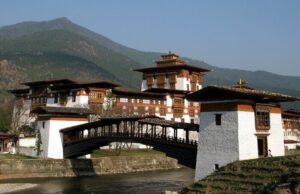
Punakha, nestled in the heart of the Himalayas, is a picturesque town in Bhutan renowned for its historical significance, natural beauty, and cultural heritage. The town served as the ancient capital of Bhutan and remains an important religious and administrative center to this day. Punakha is best known for the majestic Punakha Dzong, a stunning fortress monastery situated at the confluence of the Pho Chhu and Mo Chhu rivers. This architectural masterpiece, adorned with intricate woodwork, vibrant murals, and sacred relics, is a symbol of Bhutanese identity and spirituality. Visitors to Punakha can explore the Dzong’s ornate halls, courtyards, and prayer rooms, as well as enjoy scenic walks along the riverside and through terraced fields. The town’s serene ambiance, coupled with its rich cultural heritage, makes Punakha a must-visit destination for travelers seeking an authentic Bhutanese experience.
7). Gangteng
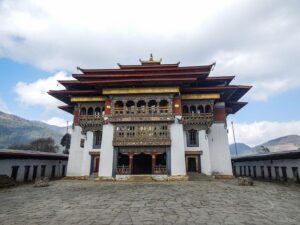
Gangteng, located in the Phobjikha Valley of central Bhutan, is a serene and picturesque destination renowned for its natural beauty and cultural significance. The valley is home to the Gangteng Monastery, also known as Gangtey Gonpa or Gangtey Monastery, which is one of the most important religious institutions in Bhutan. Built in the 17th century, the monastery is perched atop a hill overlooking the valley, offering panoramic views of the surrounding mountains and forests.
Gangteng Monastery is particularly famous for being the winter residence of the endangered black-necked cranes, which migrate to the Phobjikha Valley from Tibet each year. The arrival of these majestic birds is celebrated with the annual Black-Necked Crane Festival, held in November, where locals and visitors come together to honor and protect these cherished creatures. Gangteng and the Phobjikha Valley offer visitors a tranquil retreat amidst pristine nature, rich cultural heritage, and the opportunity to witness the harmonious coexistence of man and wildlife.
8). Trashigang
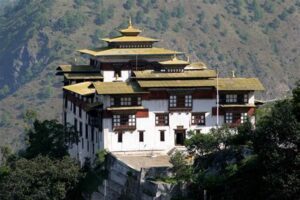
Trashigang, located in eastern Bhutan, is the country’s largest district and a vibrant cultural hub nestled amidst picturesque landscapes. Known as the “Gateway to the East,” Trashigang offers visitors a glimpse into Bhutan’s rich heritage and natural beauty. The town is characterized by its traditional Bhutanese architecture, with whitewashed buildings adorned with intricate woodwork and colorful paintings. Trashigang is also famous for its bustling markets, where locals gather to buy and sell a variety of goods, including fresh produce, handicrafts, and textiles. Visitors can explore nearby attractions such as the majestic Trashigang Dzong, perched atop a hill overlooking the town, and the scenic Drangme Chhu River Valley. With its serene ambiance, cultural richness, and stunning vistas, Trashigang invites travelers to immerse themselves in the authentic charm of eastern Bhutan.
9). Bumthang
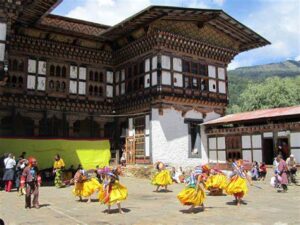
Bumthang, located in central Bhutan, is a picturesque valley revered for its natural beauty, rich cultural heritage, and spiritual significance. Often referred to as the “Switzerland of Bhutan,” Bumthang is renowned for its lush green landscapes, pristine rivers, and rolling hills dotted with traditional farmhouses and ancient monasteries. The valley is home to some of Bhutan’s most sacred sites, including Jambay Lhakhang, Kurjey Lhakhang, and Tamshing Lhakhang, which attract pilgrims and visitors seeking spiritual solace. Bumthang is also known for its vibrant festivals, such as the Jambay Lhakhang Drup and the Kurjey Tshechu, where masked dances, religious ceremonies, and cultural performances unfold against the backdrop of majestic mountains. Travelers to Bumthang can immerse themselves in the tranquility of rural life, explore scenic hiking trails, and experience the authentic charm of Bhutanese culture in this idyllic valley.
10). Phuentsholing
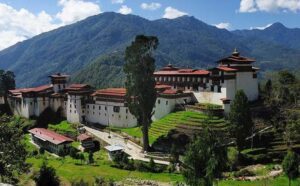
Phuentsholing, located in the southern foothills of Bhutan, serves as the primary entry point for travelers entering the kingdom by road from India. This bustling border town is a melting pot of cultures, with a vibrant atmosphere and a mix of Bhutanese, Indian, and Nepali influences. Visitors can explore the local markets, where colorful stalls offer an array of goods ranging from traditional Bhutanese handicrafts to Indian spices and textiles. Phuentsholing is also home to several religious sites, including the Zangtho Pelri Lhakhang, a temple adorned with intricate murals and statues. For those interested in Bhutanese history and culture, the Bhutan Gate Museum provides insights into the country’s past and its unique identity. With its strategic location, friendly locals, and diverse attractions, Phuentsholing offers a fascinating introduction to the kingdom of Bhutan.
11). Wangduephodrang
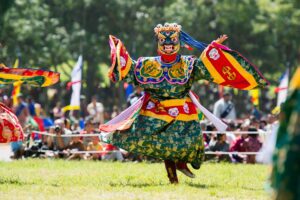
Wangduephodrang, often simply referred to as Wangdue, is a picturesque district located in central Bhutan. Known for its stunning natural beauty and rich cultural heritage, Wangduephodrang offers visitors a glimpse into traditional Bhutanese life. The district is home to the historic Wangdue Phodrang Dzong, a majestic fortress monastery perched on a ridge overlooking the Punatsangchhu River. This iconic landmark serves as a center for religious and administrative activities and hosts vibrant festivals and ceremonies throughout the year. Wangduephodrang is also renowned for its lush valleys, terraced fields, and pristine forests, making it a paradise for nature lovers and outdoor enthusiasts. Visitors can explore scenic hiking trails, visit nearby villages to experience rural Bhutanese life, or simply relax and soak in the tranquil ambiance of this charming district. Wangduephodrang offers a serene retreat from the hustle and bustle of modern life, inviting travelers to immerse themselves in Bhutan’s timeless beauty and cultural heritage.
12). Mongar
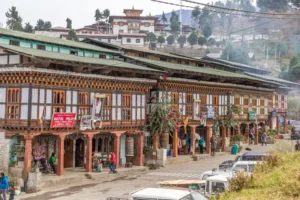
Mongar, nestled in the eastern region of Bhutan, is a picturesque town known for its stunning landscapes, rich cultural heritage, and traditional Bhutanese architecture. Surrounded by lush green hills and terraced fields, Mongar offers visitors a glimpse into Bhutan’s rural way of life and vibrant community spirit. The town is home to the historic Mongar Dzong, a majestic fortress perched atop a hilltop, which serves as a center for religious and administrative activities. Visitors can explore the dzong’s intricate woodwork, ornate murals, and serene courtyards while enjoying panoramic views of the surrounding valleys. Mongar also serves as a gateway to nearby attractions such as Lhuentse, Trashigang, and the eastern Himalayan region, making it an ideal stopover for travelers exploring the eastern part of Bhutan. With its scenic beauty, cultural significance, and warm hospitality, Mongar offers an authentic Bhutanese experience that is sure to leave a lasting impression.
13). Lhuntse
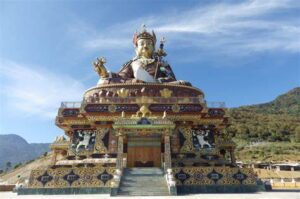
Lhuntse, located in northeastern Bhutan, is a picturesque district renowned for its pristine natural beauty, rich cultural heritage, and traditional weaving. Surrounded by towering mountains and dense forests, Lhuntse offers visitors a tranquil retreat amidst breathtaking landscapes. The district is known for producing some of Bhutan’s finest handwoven textiles, crafted by skilled artisans using traditional techniques passed down through generations. Lhuntse is also home to several sacred monasteries and shakhas (temples), including the iconic Lhuntse Dzong, which sits majestically atop a hill overlooking the valley. Visitors to Lhuntse can immerse themselves in Bhutanese rural life, trek through scenic mountain trails, and experience the timeless charm of traditional Bhutanese culture. With its unspoiled natural beauty and cultural treasures, Lhuntse is a hidden gem waiting to be explored by adventurous travelers seeking authentic experiences in Bhutan.
14). Kilung Lhakhang
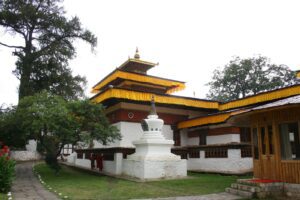
Kilung Lhakhang is a sacred Buddhist temple located in the lush greenery of Bumthang Valley, Bhutan. Nestled amidst towering trees and serene surroundings, this ancient temple holds significant cultural and religious importance for the local community. Built-in the 8th century by the Tibetan Buddhist saint Padmasambhava, Kilung Lhakhang is revered as a spiritual sanctuary and pilgrimage site. The temple is adorned with intricate murals, sacred relics, and statues, reflecting Bhutan’s rich artistic heritage and spiritual traditions. Visitors can explore the temple complex, offering prayers and seeking blessings from the resident monks. Surrounding the temple are scenic walking trails, providing opportunities for contemplation and quiet reflection in the midst of nature’s tranquility. Kilung Lhakhang encapsulates the essence of Bhutanese spirituality and serves as a haven for seekers of inner peace and enlightenment.
Map of Bhutan
